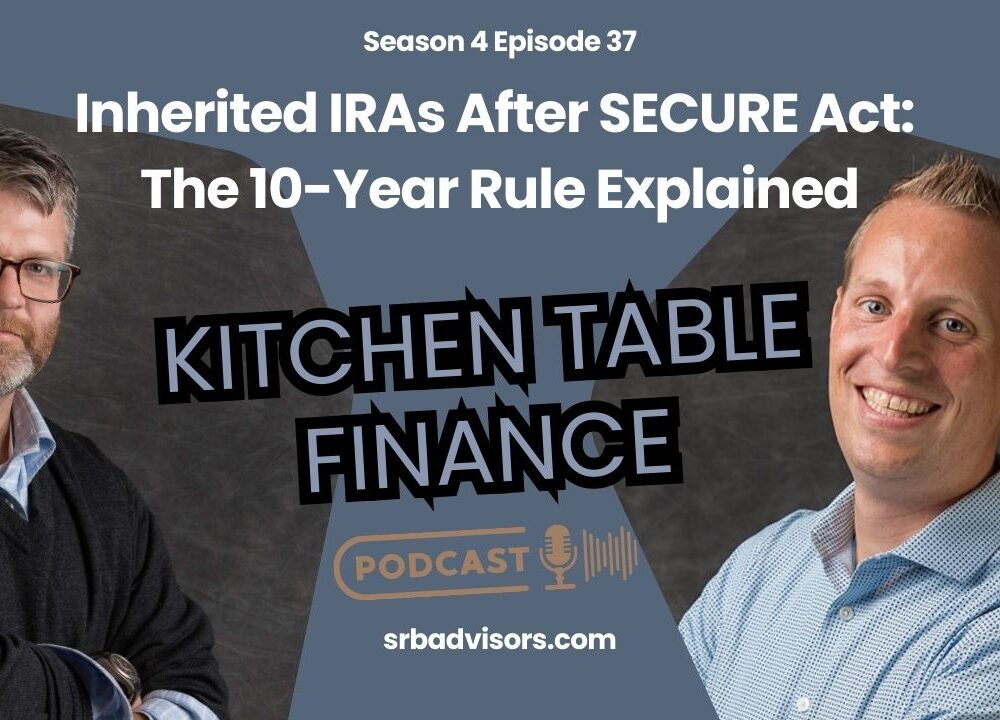Investment Philosophy and East Bay Introduction

Podcast: Play in new window | Download
Dave and Nick talk about Shotwell Rutter Baer’s investment philosophy. They also introduce their new partnership with East Bay Investment Solutions.
East Bay is an investment consulting firm providing services such as portfolio oversight, investment due diligence, and wealth management guidance tailored to meet the needs of Shotwell Rutter Baer clients. In addition, East Bay provides model portfolios that subscribe to the investment philosophy shared by Shotwell Rutter Baer that the market is reasonably efficient, that low-cost, time-tested, and liquid investments in a diversified portfolio yield financial success over time.
Link to SRB Investment Philosophy Podcast: https://srbadvisors.com/our-investment-philosophy/
Books to help build your investment philosophy:
- The Investment Answer – Daniel Goldie & Gordon Murray
- The Little Book of Common Sense Investing – John C. Bogle
- The Warren Buffett Way – Robert Hagstrom
- A Random Walk Down Wall Street – Burton Malkiel
We could neither confirm nor deny the existence of the quote Dave attributed to Jon Bogle. Regardless, we still think it’s essential to have an investment philosophy and stick to it!
SRB Investment Phiolosophy
Short–term market returns cannot be known or predicted. The markets will fluctuate daily based on the news flow and many unpredictable events. The market’s movements in response to these changes cannot be predicted. In the long run, markets respond to economic growth, and the economy grows as the population grows, as equipment wears out and needs to be replaced, and as new technologies become available.
- We recommend that cash needed for known immediate/short–term expenses should be removed from the investment portfolio.
- Rolling 36 Month periods is the minimum timeframe to evaluate performance.
The markets are usually efficient. That is a fancy way of saying that the price of any stock on any given day reflects all the known public information about that stock. The price is the average of everyone’s opinion. Some people think the price should be higher, so they are buyers, and some think the price should be lower, so they are sellers. For this reason, trying to pick individual stocks that are undervalued is a guessing game. As news comes out, the market digests that new information almost instantly and prices adjust.
Risk and expected return are related. Because the stock market outperforms bonds and cash investments over the long haul, we expect that the more stock investments included in a portfolio the higher its return should be over time. Portfolios with a lower allocation to the stock market will be less volatile but will also be expected to produce a lower long–term return.
Taking the right type of risk is important. Taking the risk of being in the market drives your long–term expected results.
- Because the market fluctuates with economic expectations, this type of risk is called “Systemic Risk.” We expect the more systemic risk you take, the more return you should expect over time.
- Another type of risk, called “non-systemic risk,” is the risk associated with any individual company’s performance. A drug company can have a bad clinical trial, or an oil company can have an accident. Individual companies can go bankrupt, leaving their stocks worthless. Because the markets are efficient, choosing individual stocks does not provide more potential return, but does mean taking more risk. For this reason, we prefer portfolios built from broad, diversified funds rather than from stocks or bonds from individual companies.
Asset Allocation is much more important than Stock Selection. Asset allocation refers to how a portfolio is divided up between stocks and bonds, and how those broad categories are broken down into types of stocks and bonds. Research has shown that 94% of a portfolio’s return comes from this decision
Brinson, Hood, and Beebower – Financial Analysts Journal – February 1995.
We believe in global diversification in any asset class where the opportunity exists. The financial markets span the globe and are interconnected, and your portfolio should reflect that with broad, global exposure.
- We prefer hedging currency risk in fixed income, but do not hedge currency exposure in more volatile asset classes like equity or real estate.
- We start with the global market portfolio and then tilt our models to match our preferred exposures.
We believe in regular rebalancing but infrequent trading. Rebalancing means returning your portfolio holdings to the target percentages assigned to the model. • Regular rebalancing mitigates portfolio risk and creates a disciplined approach to
selling assets that have risen beyond their targets and buying those that are down, compounding gains when those assets come back in favor.
- Infrequent trading means we generally do not replace managers based on short–term performance and rarely make tactical market adjustments. Limiting turnover reduces taxes and portfolio costs.
Portfolio Expenses are also important. Investment returns are only worth what you get to keep. Controlling expenses means more return goes directly to investors. Because markets are efficient, active mutual fund managers, trying to pick winning stocks that will beat the market, rarely add consistent value when their fees are factored into returns.
- This leads us to focus on low–cost, passive, or index funds and exchange-traded funds.
- In addition to controlling the internal costs of the funds in a portfolio, it is also important to control trading costs.
When practical, we will consider investment products that follow Environmental, Social, and Governance (ESG) considerations. We believe in aligning our values with our investments when doing so can be done effectively and without sacrificing diversification and portfolio performance.
Taxes Matter. Along with expenses, tax – efficiency makes a difference for non – retirement accounts.
- Active management can create capital gains taxes when portfolio managers change their stock holdings, and these taxes can further hamper returns. Building portfolios from low–cost passive mutual funds saves both expenses and taxes.
- Where appropriate we use municipal bonds for tax–free income and locate non-tax-efficient assets in retirement accounts instead of taxable accounts.
- We also limit the number of holdings in taxable portfolios and focus on low – turnover to avoid capital gains.
There are factors that can be identified which can lead to long–term outperformance. Instead of choosing individual stocks, focusing on groups of stocks with specific characteristics can lead to long–term outperformance.
- For example, smaller companies tend to outperform larger companies as a group.
- Value stocks, meaning stocks whose share price is lower than average when compared to their earnings, tend to do better than the stocks of companies whose share price is high relative to their earnings.
- Companies with higher profit margins tend to see their stocks perform better than companies with lower profit margins.
- In the bond market, this strategy means emphasizing investment-grade bonds as opposed to lower–quality bonds.
Managing asset allocations to match the markets can add value if it is done cost-effectively. While managing individual stocks does not necessarily add value to a portfolio, managing the portfolio’s asset allocation based on macroeconomic trends can add to performance if done cost-effectively. Our models generally keep the risk exposure the same – how much, overall, is invested in stocks versus bonds – but do at times shift between subcategories, such as emphasizing emerging market stocks at certain times, or adding to sectors such as health care or technology.
Complexity Does Not Mean Outperformance: Often simple answers are the best answers. Wall Street brokerage firms make a lot of money convincing investors that there are new strategies, so-called alternative investments, or other complex ways to invest that change the otherwise simple dynamic of investing in stocks for the long run. There is no free lunch in the investment world: if a particular investment plan offers higher returns for less risk, there is a cost somewhere, either in the form of fees and premiums or in lost liquidity, to make those higher returns possible.
- Non-Traditional or “Alternative” investments may be suitable in certain circumstances, but only after thorough due diligence. When appropriate, we generally recommend limiting these assets to 5% of a portfolio for each position and 20% overall.
Staying invested over the long haul, in a portfolio that is tax-efficient and cost-effective and takes the appropriate amount of risk for you and your goals is the key to long-term success.
About Shotwell Rutter Baer
Shotwell Rutter Baer is proud to be an independent, fee-only registered investment advisory firm. This means that we are only compensated by our clients for our knowledge and guidance — not from commissions by selling financial products. Our only motivation is to help you achieve financial freedom and peace of mind. By structuring our business this way we believe that many of the conflicts of interest that plague the financial services industry are eliminated. We work for our clients, period.
Click here to learn about the Strategic Reliable Blueprint, our financial plan process for your future.
Call us at 517-321-4832 for financial and retirement investing advice.
Share post:
